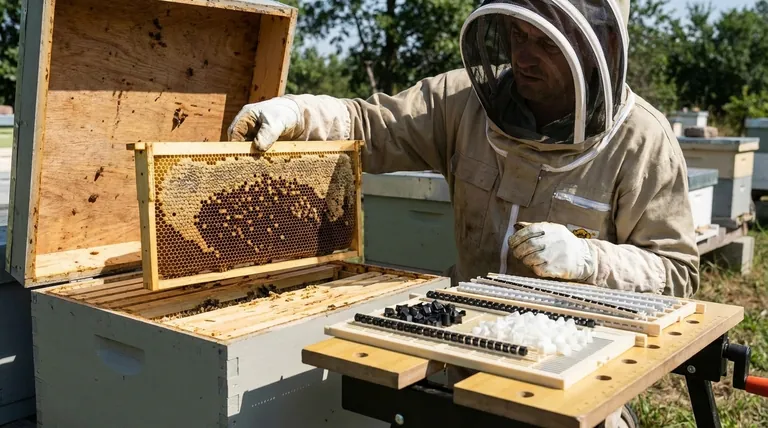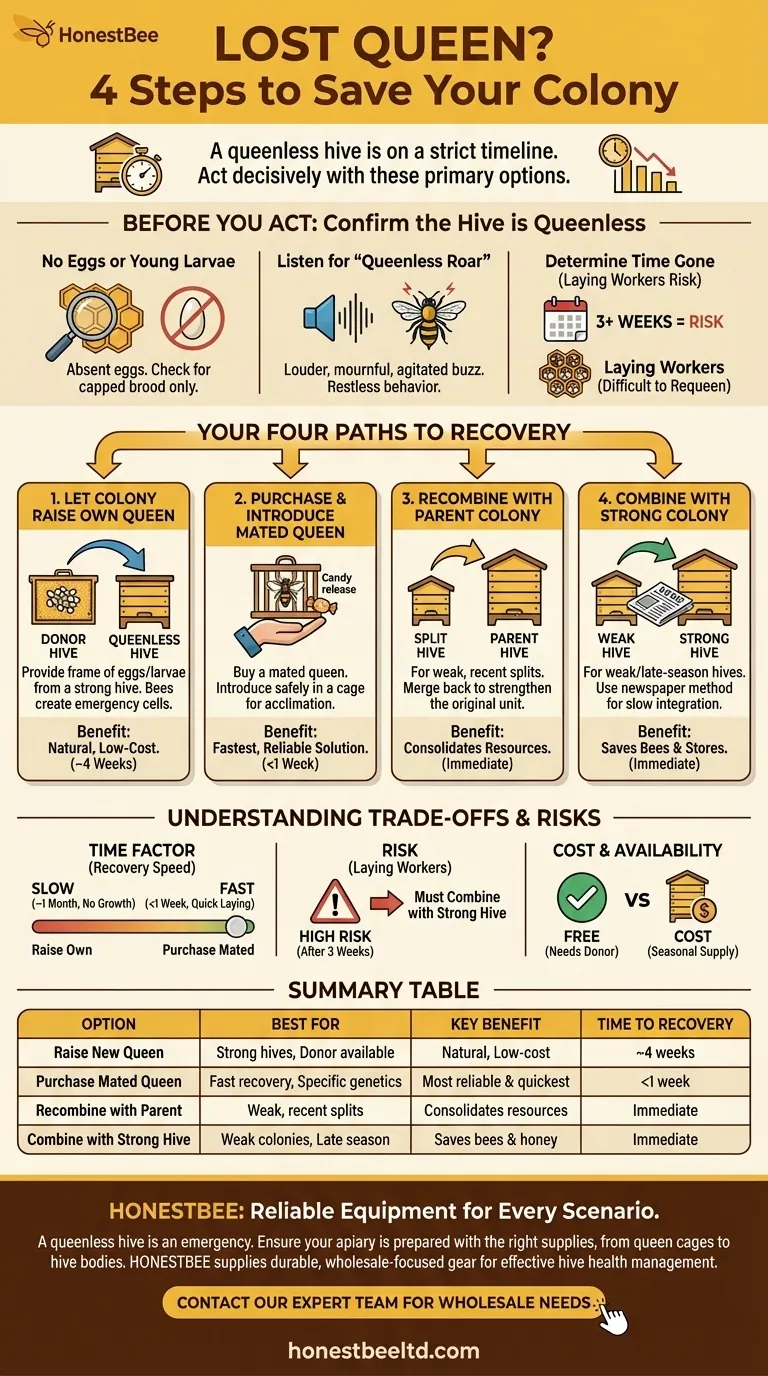When a beehive loses its queen, you have four primary options to save the colony. You can provide a frame of eggs from another hive, allowing the bees to raise a new queen themselves. Alternatively, you can purchase a mated queen, recombine the colony with its parent hive if it was a split, or merge it with another strong colony.
A queenless hive is on a strict timeline. The absence of a queen means no new eggs are being laid, and the colony's population will rapidly decline. Your choice of action depends entirely on the strength of the queenless hive, the time of year, and the resources you have available.

Before You Act: Confirm the Hive is Queenless
The first and most critical step is to be certain the queen is truly gone. A misdiagnosis can lead you to disrupt a healthy colony or even kill a viable, undetected queen.
The Telltale Signs: No Eggs or Young Larvae
The most reliable indicator of a queenless hive is the complete absence of eggs. A healthy queen lays consistently, so you should see eggs, which look like tiny grains of rice, in the center of the brood frames.
If you see only capped brood or older larvae but no eggs, the queen has been missing for at least three days.
Listen for the "Queenless Roar"
A queenless colony often exhibits a distinct change in behavior. When you open the hive, you may hear a louder, more agitated, and somewhat mournful buzz, often referred to as the "queenless roar."
The bees will also seem more restless and less organized than a typical, queenright colony.
Determine How Long She Has Been Gone
The amount of time the colony has been without a queen dictates your options. If it has been more than three weeks, the colony may develop laying workers—worker bees that begin laying unfertilized eggs.
Laying workers create a chaotic brood pattern with multiple eggs per cell, and their presence makes introducing a new queen extremely difficult.
Your Four Paths to Recovery
Once you have confirmed the colony is queenless, you must act decisively. Each option serves a different strategic purpose.
Option 1: Let the Colony Raise Its Own Queen
This is the most natural method. By placing a frame containing freshly laid eggs and young larvae from a strong, healthy hive into the queenless colony, you give the workers the raw material they need.
The nurse bees will select several young larvae and feed them a special diet of royal jelly, creating emergency queen cells to raise their own new monarch.
Option 2: Purchase and Introduce a New Queen
This is the fastest and most reliable way to get a colony back on track. You can purchase a mated queen from a reputable bee supplier.
She arrives in a small cage with attendants. You place this cage in the hive for several days, allowing the colony to acclimate to her pheromones before releasing her.
Option 3: Recombine with the Parent Colony
This option is specific to a situation where your queenless hive was a recent "split" from a larger, parent colony.
If the split is weak and has lost its queen, the most practical solution is often to cut your losses and merge it back with the original hive, strengthening one single unit.
Option 4: Combine with Another Strong Colony
If the queenless colony is weak, has a dwindling population, and it's too late in the season to raise a new queen, the best course of action is to save the bees themselves.
By combining them with a strong, queenright colony, you bolster the population of the healthy hive, ensuring those resources (bees and honey) are not lost. This is typically done using the newspaper combine method to ensure a slow, peaceful integration.
Understanding the Trade-offs and Risks
Choosing the right path requires understanding the implications of each decision. There is no single "best" answer, only the best answer for your specific situation.
The Time Factor: Raising vs. Buying
Raising a new queen is a long process. From egg to a fully mated, laying queen takes approximately one month. During this time, the colony's population will not grow.
Buying a mated queen can have the hive productive and laying eggs again in less than a week. This speed is a significant advantage, especially if there is a nectar flow you want to capitalize on.
The Risk of Laying Workers
A colony that has been queenless for too long is a serious problem. Once laying workers are established, they see themselves as the hive's reproductive force and will often kill any new queen you try to introduce.
If you suspect laying workers, your best and often only option is to combine the hive with a very strong, queenright colony.
Cost and Availability
Letting bees raise their own queen is free but requires that you have a donor hive with eggs. Purchasing a queen has a direct cost and depends on seasonal availability from suppliers.
Making the Right Choice for Your Hive
Your decision should be a calculated one based on the state of your colony and your goals as a beekeeper.
- If your hive is strong and you have other healthy hives: Letting them raise their own queen by providing a frame of eggs is an excellent, low-cost option.
- If you need a fast solution or want to ensure good genetics: Purchase a mated queen from a reputable supplier to minimize downtime.
- If the queenless colony was a recent, weak split: Recombine it with the parent hive to consolidate your resources into one strong unit.
- If the colony is very weak or has laying workers: Combine it with a different strong hive to save the bees and their stores.
Ultimately, swift and accurate diagnosis is the key to successfully navigating the loss of a queen and ensuring your colony's survival.
Summary Table:
| Recovery Option | Best For | Key Benefit | Time to Recovery |
|---|---|---|---|
| Raise a New Queen | Strong hives with a donor colony | Natural, low-cost method | ~4 weeks |
| Purchase a Mated Queen | Fast recovery, specific genetics | Most reliable and quickest solution | <1 week |
| Recombine with Parent Hive | Weak, recent splits | Consolidates resources | Immediate |
| Combine with Strong Hive | Weak colonies, late season | Saves bees and honey stores | Immediate |
Ensure your apiary is prepared for any scenario with reliable equipment from HONESTBEE.
A queenless hive is a critical emergency. Having the right supplies on hand—from queen cages for safe introduction to strong hive bodies for successful combinations—is essential for a swift recovery. HONESTBEE supplies commercial apiaries and beekeeping equipment distributors with the durable, wholesale-focused gear needed to manage hive health effectively.
Don't let a lost queen mean a lost colony. Contact our expert team today to discuss your wholesale equipment needs and keep your operations thriving.
Visual Guide

Related Products
- No Grafting Queen Rearing Kit: System for Royal Jelly Production and Queen Rearing
- Jenter Queen Rearing Kit Complete Set for Bee Breeding
- Nicot Queen Rearing Kit for Beekeeping and Grafting in Nicot System
- Retractable Chinese Queen Rearing Grafting Tools Equipment
- Brown Nicot Queen Cell Cups for Breeding Queen Bees Beekeeping
People Also Ask
- What are the stages involved in queen raising? A Guide to Controlled, High-Quality Queen Production
- What are the two main categories of queen rearing methods? Grafting vs. Non-Grafting Explained
- What is the timeline for queen breeding? A 28-Day Guide from Egg to Laying Queen
- What are the signs that indicate a colony needs requeening? Protect Your Hive's Health and Productivity
- How can beekeepers start a honey bee breeding program? Build a Superior, Resilient Apiary



















